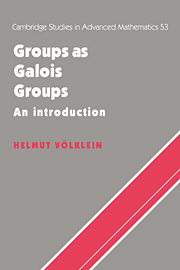Book contents
9 - Braiding Action and Weak Rigidity
Published online by Cambridge University Press: 22 September 2009
Summary
Weakly rigid (Galois) extensions of ℂ(x) are those that are uniquely determined by their ramification type T. If such an extension L/ℂ(x) is even rigid then its minimal field of definition equals a certain field κT that is quite explicitly given in terms of the ramification type T. Thus G = G(L/ℂ(x)) occurs as a Galois group over κT(x), and this yields the rigidity criteria from Chapter 3.
In the weakly rigid case, we still get a Galois realization over the field κT(x); not for G, however, but for a certain group GT of automorphisms of G (that contains the inner automorphisms); see Proposition 9.2. This raises the question of computing GT, or equivalently, the image of GT in Out(G). In general, this is a very difficult question, essentially equivalent to the regular version of the Inverse Galois Problem (since every finite extension of ℂ(x) embeds into a weakly rigid one). A partial answer can be given in the “generic” case that the branch points of L/ℂ(x) are algebraically independent. Then the image of GT in Out(G) has a normal subgroup Δ that can be described purely combinatorially in terms of the ramification type T. This description involves the braiding action on generating systems of G (Theorem 9.5).
The proof of this theorem is given in Chapter 10. It requires topological and analytic methods, as for Riemann's existence theorem.
- Type
- Chapter
- Information
- Groups as Galois GroupsAn Introduction, pp. 155 - 177Publisher: Cambridge University PressPrint publication year: 1996



